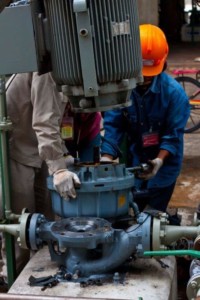Machinery Improvement®
Skills Enhancement Workshop I
Course Objective
To identify common sources of premature machinery failure and define precision mechanical maintenance practices to improve performance and extend machinery life.
Format
Five days
Summary
This workshop is designed to get the most critical part of a Machinery Improvement® Program into action. Skills and awareness to both maintain and considerably improve your equipment are presented and practiced in a practical, easy to understand format. This workshop is divided equally between lecture time and hands-on exercises.
Understanding Vibration Terminology and Analysis
Using vibration “overall” measurements as a yardstick to determine machine condition, workshop participants visually see the effects of common assembly errors, improper alignment practices, and basic resonance detection.
The effects of precision maintenance practices are illustrated in before-after comparisons of machine performance. Financial case histories are presented to further justify the need for a “precision attitude” and detailed documentation of all machinery improvement observations and corrections. Participants are introduced to vibration frequency analysis terminology and methods to show the need for teamwork between the craftspeople, vibration analysts, and engineering specialists.
Learn Precision Alignment Fundamentals
Workshop participants are provided with a pre-alignment check list that emphasizes the importance of determining the machine train condition before performing a precision alignment. Pipe strain, base preparation, and soft foot problems are discussed in detail, and the importance of documentation is further emphasized. An introduction to thermal growth is presented, including calculating the thermal growth from measurements on the machine and offsetting for thermal growth in the alignment corrections. Graphing techniques applicable to all precision alignment methods, including laser devices, are employed to develop optimum moves for bolt-bound or base-bound situations. To practice the lessons learned, participants align a motorized demonstration unit to precision tolerance while eliminating soft foot and numerous assembly errors.
Understand Precision Balancing and the Cumulative Effect of Assembly Errors
Balance tolerances according to API and ISO are discussed, and recommended precision tolerances are defined. The cumulative effects of improper key length, unbalanced couplings, set screw convention, and other assembly errors are discussed, and corrective measurements are introduced.
Understand Bearing Life and Why Bearings Fail Early
Bearing design life and factors that lead to early failure such as improper handling and installation, over-lubrication, and excessive loads due to misalignment and unbalance are discussed. This is emphasized by a hands-on bearing fit exercise. An overview of bearing types and loads support is presented.
Who Should Attend:
- Mechanics and Technicians
- Maintenance Foreman and First-line Supervisors
Course Content
Overview of Precision Maintenance and Machinery Improvement
- Understanding proactive (rather than reactive) maintenance philosophy
- Overview of Vibration Control
- Understanding the sources for machinery vibration
- Practical understanding of resonance
- When to use displacement, velocity, and acceleration units
- The use of phase for more accurate vibration analysis
- Demonstrations on vibration due to misalignment and soft feet
- Basic resonance understanding and detection
Understanding the Reasons for Obtaining and Maintaining Precision Balance
- How assembly errors occur
- The purpose for close precision tolerances
- Basic analysis techniques to separate symptoms of unbalance from misalignment
Precision Assembly Techniques
- Determining proper key length
- Proper fitting of shafts and bores to preserve precision balance
- Avoiding and correcting pulled threads
- Proper set screw based assembly
- Preventing loss of precision balance from burrs, dings and dirt
- Care and procedures in assembling and lubricating couplings
- Correcting the effects of non-square spacers
Techniques for Maximizing Bearing Life Bearing Life Expectancy
- Hands-on fit tolerance exercises
- Why bearings fail early
- Overview of major bearing failure categories
- Recognizing different bearing types, their application and carrying capacity
Obtaining Precision Alignment
- Overview of alignment methods
- Pre-alignment checks and procedures
- Machinery soft foot measurement, analysis and correction
- Procedures and precautions for taking accurate readings and measurements
- Precision movement of machinery
- Calculating alignment corrections with graph, calculator or computer
- Hands-on precision alignment exercise for machines not subject to thermal growth
- Finding the optimum moves when both machines must be moved
- Correcting for thermal growth on basic machinery
- Hands-on exercises
“This workshop was conducted at such a pace that our employees were challenged and continually provided with new information. I was impressed that the instructor would first convince our mechanics, analysts, and supervisors on the need to perform a certain task, then provide them actual hands-on training. It was very refreshing to see our people so excited and interested in learning how to perform precision work.”
Gas Plant
Maintenance and Reliability Manager
Texaco Exploration and Production Inc.
